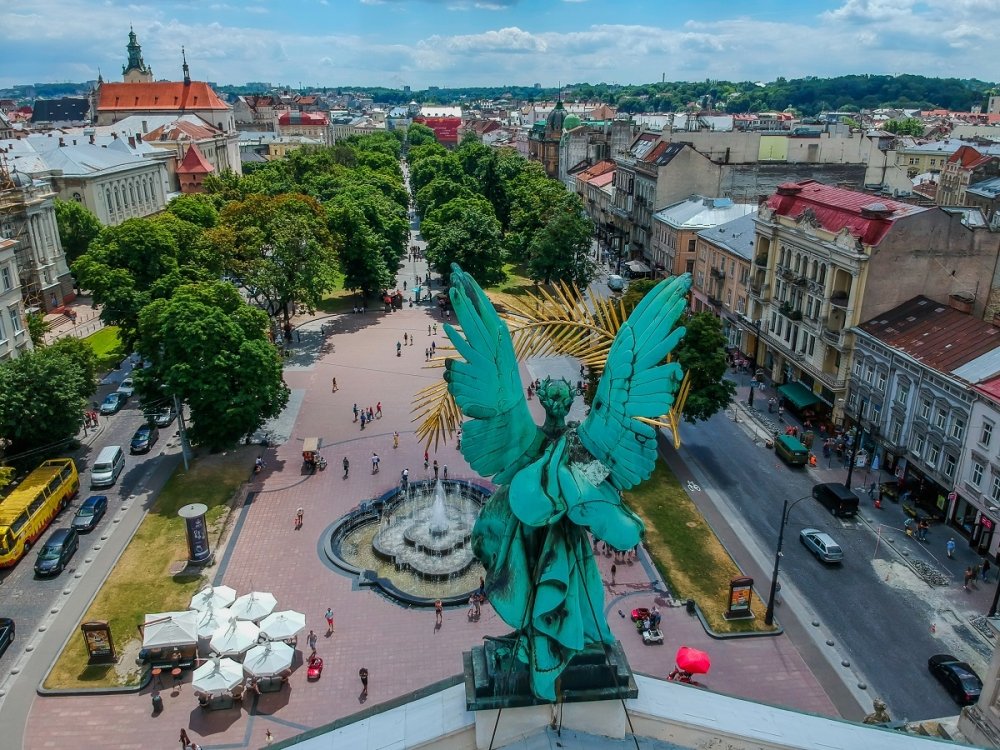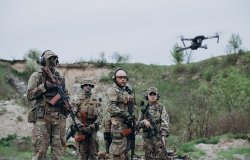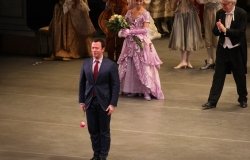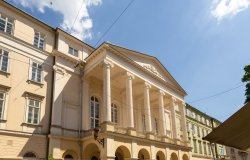
A blog of the Kennan Institute
New Lights in the Shadow of War
As the war in Ukraine continued at a barbarous level last March, the Lviv National Opera’s ballet company premiered an ambitious new work, Light from the Shadows, grounded in the third part of Mykhailo Kotsyubynsky’s important novel, Shadows of Forgotten Ancestors. Based on an original libretto by Vasyl Vovkun and music by Ivan Nebesnyy, this innovative ballet, featuring more than a dozen dancers, could well become a staple of postwar ballet repertoire.
Kotsyubynsky’s novel of star-crossed young lovers has inspired many artists to bring its tale of young love, clan conflict, witchcraft, and folklore to life since its publication in 1912. Ivan and Marichka, a couple from two rival Hutsul families in the Carpathians, seem ready-made for stage and screen. The first ballet based on the novel, with music by Vitalyn Kyreiko, premiered in 1960. Sergei Parajanov’s internationally celebrated film of the same title followed in 1964, set to an acclaimed screen score by Myroslav Skoryk. An adaptation to mark Kotsyubynsky’s centennial was performed in 2014.
Kotsyubynsky wrote his lyrical and philosophical novel following a visit to the Carpathian village of Kryvorivnya in 1910. The settlement is just north of today’s Ukrainian border with Romania in the western Ivano-Frankivsk region. The Hutsul inhabiting the area remained pagans until well into the 20th century, and celebrated a magical world hidden in the surrounding mountains. Their tales and lifestyle fascinated Kotsyubynsky.
The Hutsuls, whose language is a dialect of Western Ukrainian, most likely originated as a mix of Slavic tribes who fled to the Carpathian Mountains to escape invading Mongols during the 13th century. Once in the mountains, the Hutsuls developed their own distinctive folkways.
The origin of their tribal name is lost in time, perhaps having been derived from the Romanian word for “outlaw,” or the Slavic word for “nomad.” Known for colorful craftsmanship in clothing, woodworking, and pottery—as well as for their traditional songs and dances—the Hutsuls became a prime subject for folkloric studies as 19th- and 20th-century transportation and communications systems encroached on their isolation.
Kotsyubynsky, a provincial (zemstvo) statistician fascinated by local folkways, was known for his picturesque portrayals of traditional customs and peoples. He authored several collections of ethnographic tales as well as nearly two dozen novels (including the sprawling Fata Morgana, published in parts between 1906 and 1910). His interest in local traditions brought him into recurring conflict with Tsarist officials until his death in 1913, at the age of 48.
Today’s two-hour retelling of Kostyubynsky’s tale of romance, sorcery, and death marks an eminent achievement for the artists involved, especially given the war that raged while they worked. Librettist Vovkun enjoyed a successful theater career in Lviv and Kyiv before serving as minister of culture and tourism in the second government of Prime Minister Yulia Tymoshenko between 2007 and 2010. Composer Nebesnyy studied with Skoryk, the composer of the celebrated score for Parajanov’s film, before continuing his training in composition in Austria. He is the founder of the contemporary music ensemble Cluster, which has performed widely over the past 30 years around Ukraine, Europe, North America, and Asia, and he directed the Kyiv Music Fest between 2006 and 2012. Lithuanian artist Arvydas Buynauskas, who created the sets and costumes, is a rising star in European theater design.
The Lviv National Opera has been among the first Ukrainian cultural institutions seeking to return to a modicum of normality following the Russian full-scale invasion in February 2022. The company presented a full schedule of well-known works this season, including the operas Carmen and Don Juan and the ballets Don Quixote and Esmerelda. Housed in one of Ukraine’s most storied theaters (see blog post of April 28, 2023), and away from the front lines of the war, the company has tried to provide a respite to audiences that include soldiers, evacuees, and local residents.
In a turn to the future, the company has also drawn on support from Western partners to mount new works such as Light from the Shadows. By doing so, they offer a hint of a postwar Ukrainian culture that looks forward as well as back.
The opinions expressed in this article are those solely of the author and do not reflect the views of the Kennan Institute.
See our newest content first.
Subscribe to receive the latest analysis from Focus Ukraine
About the Author

Blair A. Ruble
Former Wilson Center Vice President for Programs (2014-2017); Director of the Comparative Urban Studies Program/Urban Sustainability Laboratory (1992-2017); Director of the Kennan Institute for Advanced Russian Studies (1989-2012) and Director of the Program on Global Sustainability and Resilience (2012-2014)

Kennan Institute
The Kennan Institute is the premier US center for advanced research on Russia and Eurasia and the oldest and largest regional program at the Woodrow Wilson International Center for Scholars. The Kennan Institute is committed to improving American understanding of Russia, Ukraine, Central Asia, the Caucasus, and the surrounding region though research and exchange. Read more











